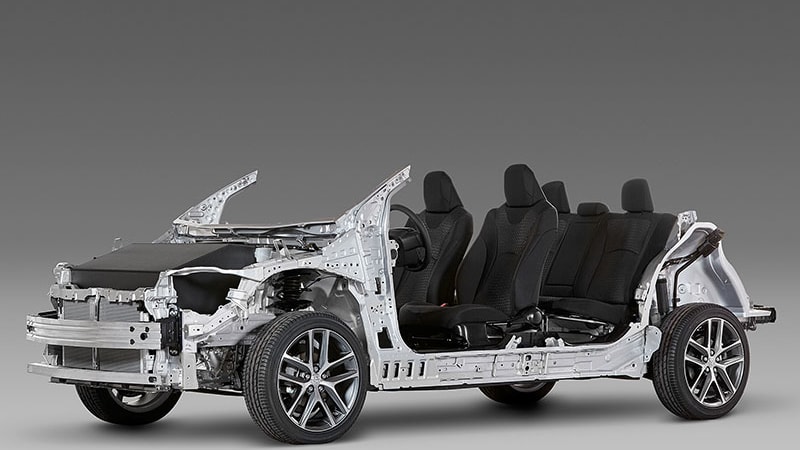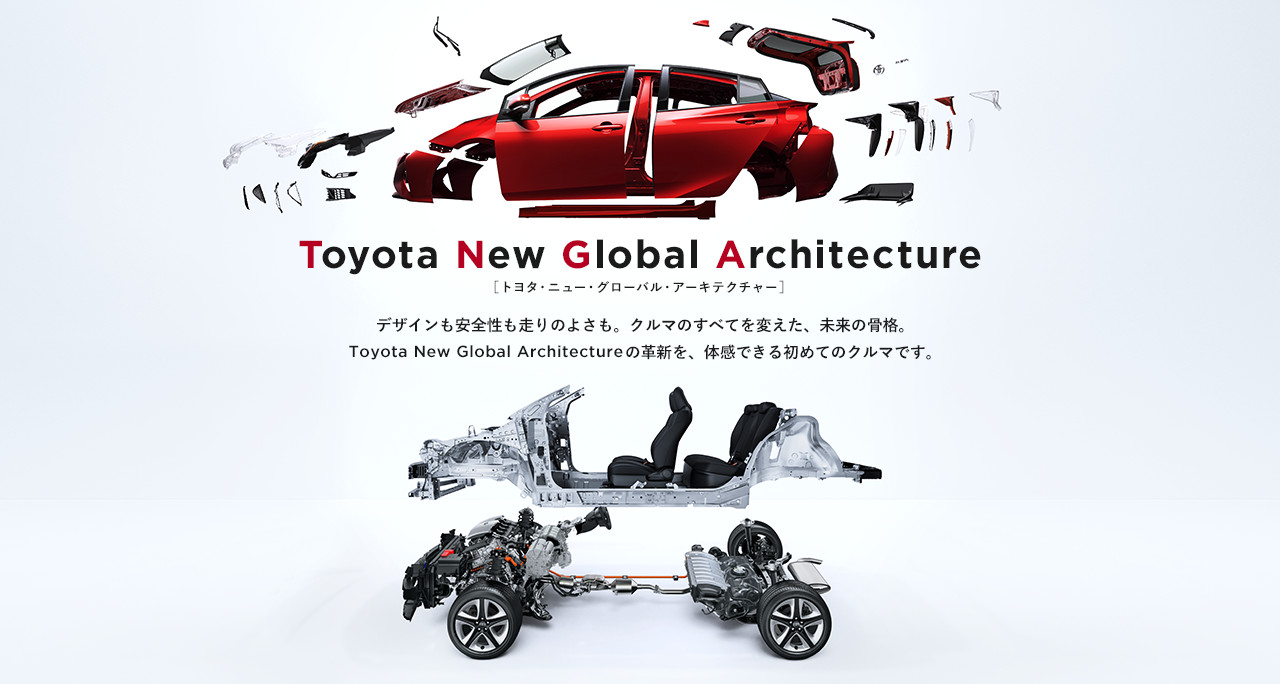Toyota's new TNGA platform could boost Prius to 58 mpg

First, let's put the necessary context around the phrase, "Toyota New Global Architecture platform." The platform is important, but it is just one flowering bud sprouting from the real action, which is the production processes that will create it. It is crucial to understand that TNGA is fundamentally about a revolution in how Toyota designs and builds its cars - it even includes an overhaul of management and human resources - with one of the benefits being the new platform that the 2016 Prius will ride on.
The Daily Kanban goes in depth about the changes, but integrated development for powertrain and platforms serves to reduces costs through more parts-sharing at the same time as it creates more cohesive platforms that are lighter, more compact, and have more efficient layouts. Regarding hybrids, Toyota says the new drive unit layout along with small components could raise hybrid efficiency "by more than 15 percent." That might enable the 2016 Prius to return 57.5-mpg combined - almost 59 in the city, 55 on the highway. Plus, the higher rigidity, lower center of gravity, and better suspension of the new platform will provide a better driving experience. All of these changes will be reflected in platforms for large and rear-wheel-drive vehicles, too.
It is factory and build-process refinement that allows the development advances to be fully exploited. Toyota is making its lines more flexible, partly by having actual assembly lines that can easily be shortened, lengthened, or trucked somewhere else, and partly by introducing machines that can build parts for many different vehicles on the same line as needed, without using molds. The flexibility extends to capital investment, too, with much less money needed in order to switch to a new product build.
Toyota says it is doing this to "improve core vehicle performance and product appeal," the overhaul making it simpler to produce new designs and features. Factory workers benefit from the flexibility as well; being able to build more types of cars means they aren't hamstrung by the sales fortunes of a small number of models. You'll find plenty of specifics in the press release below.
Show full PR text Making Ever-better Cars: A Progress Report
"Sudden and drastic changes in the business environment mean that conventional ways of thinking and doing business can no longer help us grow sustainably. We are at a crossroads where we must now build a new business model."
- Toyota President Akio Toyoda
Toyota City, Japan, March 26, 2015 -- In the four years since announcing its new Global Vision, Toyota has made significant progress toward achieving sustainable growth by making ever-better cars. This has required a new approach to manufacturing automobiles, with the core aims being greatly improved product development and more competitive production sites. This work is based on the Toyota New Global Architecture (TNGA) and is supported by the cultivation of a skilled and capable workforce.
Commenting on progress made so far, Toyota President Akio Toyoda said: "I want 2015 to be a year in which we take steady and bold steps toward sustainable growth. We can do this by launching new models that incorporate TNGA, and making good use of this intentional pause to strengthen our competitiveness. Based on the new management structure we announced this month, it is important that we improve our true competitiveness, including strengthening our human resources. We aim to be a company that grows sustainably?a tree with a strong trunk."
Making better cars through TNGA
To greatly improve core vehicle performance and product appeal, Toyota is implementing an innovative, integrated development approach for powertrain components and vehicle platforms. Development of vehicles is also being grouped to promote strategic sharing of parts and powertrain components with the goal of reducing resources required for development by 20 percent or more. And by working even closer with suppliers, Toyota intends to further reduce costs and reinvest the resulting resources into developing advanced technologies and strengthening product appeal.
New powertrain components
Powertrain components are at the heart of all vehicles. Their development needs to be coordinated with that of vehicle platforms, which form the basic structure of all vehicles. To enhance driving performance and fuel efficiency while also giving vehicles more attractive styling and improved handling, Toyota is focusing on joint development of powertrains and platforms together to create a lower center of gravity, on making components lighter and more compact, and on applying unified design through modularization. By improving thermal efficiency in engines and energy-relay efficiency in transmissions, Toyota has increased the overall fuel efficiency of its powertrains by approximately 25 percent and overall power output by more than 15 percent. Also, by rethinking drive unit layout and making electric motors, inverters and batteries smaller, Toyota expects to improve the overall fuel efficiency of its hybrid vehicle systems by more than 15 percent. Toyota will begin introducing its new powertrain units this year, and will continue to develop innovative new hybrid systems, transmissions and engines.
New vehicle platforms
Toyota has developed new platforms through innovative improvements to its vehicle underbodies and suspensions. Additionally, repositioning and lowering the center of gravity of powertrain components has contributed to achieving attractive, low-stance designs, responsive handling, a high-quality drive feel, and collision performance that offers safety and peace of mind. By rethinking body structure, Toyota plans to first increase overall body rigidity by as much as 30 to 65 percent, and then further improve rigidity by joining body components using laser screw welding technology. Toyota will begin rolling out its new platforms with the launch of a midsize front-wheel-drive vehicle this year, followed by specific new platforms for front-wheel-drive compact and large vehicles, as well as for rear-wheel-drive vehicles. Toyota expects approximately half of its vehicles sold worldwide in 2020 to feature the new platforms.
Improving Toyota's production systems
After deciding to take an intentional pause to strengthen its competitiveness, Toyota froze new production plant projects and has been working to achieve full use of existing plants and facilities, and to reduce the amount of capital investment required at plants when new vehicle models are launched. Toyota is also working to make plants more competitive by greatly reducing required levels of initial investment and further strengthening environmental performance and safety.
To increase product appeal, Toyota is developing production technologies that will make it easier than ever to turn new designs and features into reality. Toyota is also doing more to cultivate its human resources ahead of entering a new stage of sustainable growth.
Fully using existing plants and facilities
Since 2013, Toyota has been increasing the versatility of its production lines, linking production of same-model vehicles across multiple plants and steadily increasing operational availability to make thorough use of even the smallest capacity surpluses at each plant. Toyota has subsequently increased its total global load factor (line utilization rate) to more than 90 percent from approximately 70 percent in 2009.
Reducing investment needed to produce new models
This year, Toyota is aiming to reduce the amount of capital investment required to prepare a production line for a new model by approximately 50 percent compared to 2008 levels. This work also covers the production of new engines, transmissions and related components.
Although rolling out new TNGA platforms and powertrain components will temporarily require increased production line investment, investment requirements are still expected to result in lower investment levels than those required in 2008. And, because TNGA's strategic sharing of parts and components allows multiple platforms and powertrain components to be added to a line for mixed production, Toyota will be able to respond flexibly to changes in demand and achieve significant reductions in overall production line investment.
Increasing plant competitiveness
Toyota is combining the results of its work to increase plant competitiveness with the mindset and technologies accumulated by making ever-better cars in the field of production engineering. Toyota aims to break the mold by creating production sites that are competitive and built for sustainable growth.
Toyota is now approaching the point at which it can expect to reduce initial plant investment by approximately 40 percent compared to 2008 levels. The main contributors include measures to achieve "simple and slim" production lines, such as downsizing painting-booth facilities and switching to compact equipment that can be installed on top of plant floors. By contrast, current plants often require large equipment that needs to be suspended from ceilings or fixed into the plant floor. This reduction in required investment frees up resources.
Also, by making plants more environment friendly through improved energy management, Toyota expects to reduce plant CO2 output by up to 55 percent.
Through these combined projects, Toyota aims to shift to plants that are always competitive, rather than plants that depend on volume.
Making ever-better cars in the field of production engineering
Toyota is using the resources gained through its investment-reduction initiatives to further improve product appeal in the field of production engineering. Production engineering initiatives, with new technologies already finding their way onto a number of mass-production vehicle models, include revolutionizing forming technologies to allow the production of highly stylish components and developing more-advanced welding technologies for greater body rigidity.
Source






